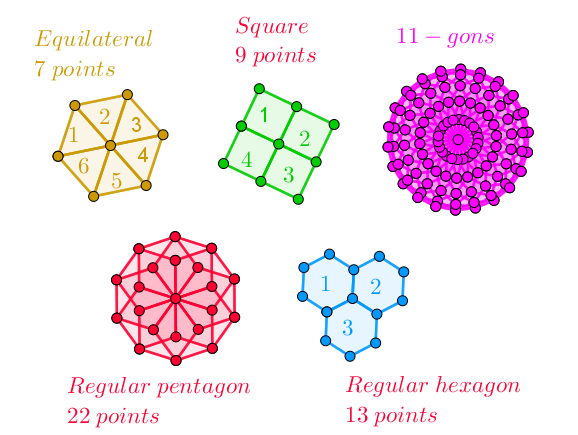Let $A_{11}A_{12}\cdots A_{1n}$ be a regular $n$ polygon, we call $A_{11}A_{12}\cdots A_{1n}$ is the $1st-n-gons$. Now we construct the $2nd-n-gon$ based two condition as follows:
$2nd-n-gons$ is regular $n-gons$ with a side $A_{1n}A_{11}$.
$2nd-n-gons$ and $1st-n-gons$ with the same orientation.
Let $2nd-n-gons$ is $A_{21}A_{22}A_{23}\cdots A_{2n}$ where $A_{21}=A_{1n}$ and $A_{22}=A_{11}$
Construct $3rd-n-gons$ based two condistions as follows:
$3rd-n-gons$ is regular $n-gons$ with a side $A_{2n}A_{11}$.
$3nd-n-gons$ and $1st-n-gons$ with the same orientation.
Let $3rd-n-gons$ is $A_{31}A_{32}A_{33}\cdots A_{3n}$ where $A_{31}=A_{2n}$ and $A_{32}=A_{11}$
Construct the $kth-n-gons$ are similarly construction of $2nd-n-gons$ and $3rd-n-gons$. Then the chain of these gons must be close.
My question: How many points appear in the plane when the chain of n-gons is close?
Example:
$n=3$, construct 6 equilaterals then these chain is close and the number of points is $7$
$n=4$, construct 4 squares then these chain is close and the number of points is $9$
$n=5$, construct $10$ regular pentagons then these chain is close and the number of points is $22$
$n=6$, construct $3$ regular hexagons then these chain is close and the number of points is $13$
See also

